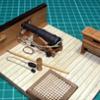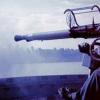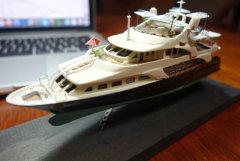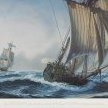-
Posts
5,889 -
Joined
-
Last visited
Reputation Activity
-
 BANYAN reacted to michael mott in Bristol Pilot Cutter by michael mott - 1/8 scale - POF
BANYAN reacted to michael mott in Bristol Pilot Cutter by michael mott - 1/8 scale - POF
I worked on the topmast today and that led to reading up on the topmast shrouds and so a cross tree was made out of some fine grained Pine.
the first picture shows the new spreaders for the topmast shrouds.
When I machined the hole for the bottom sheave to set up the hoisting rig I did not get the hole right, it was too long ans off centre so I cut a new stick and decided to cut in the sheave slot before shaping it. screw up #2 I made the slot the same length.
I embarked on stick #3 this one from some really nice clear spruce I got the bottom sheave done correctly and then started to shape the topmast.
Using the drafting template for roundness once i got close to the diameter I needed, I began the task of final fitting in order to reach I rolled over the other bench as a platform to stand on.
This made the fitting easier.
The topmast has to rise up high enough for the sheave to clear the bolster and leave enough room for the fid. There were a lot of fitting trials befor the sheave cleared. and I seemed to have a problem nearing the finish, then it occurred to me that I was hitting the ceiling because I had left the topmast a little longer. One i removed about 1/2 inch from the top I was able to hoist the mast high enough.
Feels a bit precarious working up so high.
and an overall shot of the days work.
That's all for now
Michael
-
 BANYAN got a reaction from dashi in HM Bark Endeavour by dashi - Caldercraft - scale 1:64 - 1768-71 - bashed kit
BANYAN got a reaction from dashi in HM Bark Endeavour by dashi - Caldercraft - scale 1:64 - 1768-71 - bashed kit
Hi Dashi, the mentions of the Plane Table above set me looking back through your recent posts and I must admit I missed this. That is a very interesting interpretation of the tiller 'bridge' and I think you have arrived at a very creditable representation. From a navigation and Survery perspective alone, Cook would have need some sort of work area to achieve the high standard (and accuracy) of his surveying. I had given that some thought during my build but did not put in the same level of effort you have. Congratulations: I think this idea is worth much further discussion in an academic study.
Your solution also makes better sense of that log entry about a bridge over the tiller. In the past this has been interpreted literally; that is, a means of crossing from one side to the other. Your interpretation provides for the other sense also, that of a 'bridge' as we know it in modern ships; while also providing a very 'workable' surveying station. do you think there would also have been a large chart table?
cheers
Pat
-
 BANYAN got a reaction from popeye the sailor in Great Republic 1853 by rwiederrich - FINISHED - four masted extreme clipper
BANYAN got a reaction from popeye the sailor in Great Republic 1853 by rwiederrich - FINISHED - four masted extreme clipper
Very neat belaying Rob; looks good!
cheers
Pat
-
 BANYAN reacted to rwiederrich in Great Republic 1853 by rwiederrich - FINISHED - four masted extreme clipper
BANYAN reacted to rwiederrich in Great Republic 1853 by rwiederrich - FINISHED - four masted extreme clipper
Passing line down through the top can be tricky...and keeping lines from tangling and twisting is a priority.
-
 BANYAN reacted to Dr PR in USS Oklahoma CIty CLG-5 (1971) 3D CAD model
BANYAN reacted to Dr PR in USS Oklahoma CIty CLG-5 (1971) 3D CAD model
AFTER SUPERSTRUCTURE AND TOWER
For the CLG conversion everything above the main deck aft of the midships superstructure was removed. The triple 6"/47 turrets #3 and #4, dual 5"/38 gun mounts #54, #55 and #56, the aft Mk 34 and Mk 37 directors and the deck houses around them, and the aircraft catapults and crane were scrapped. In their place a huge armored missile house was built on the main deck and a new after superstructure and tower were built on top of the missile house. The entire after deck house was part of the Talos guided missile launching and guidance system.
The missile house contained the Mk 7 Guided Missile Launching System where the missiles were stored and serviced. The house was made of 1 1/2" Special Treated Steel (armor plate). Including 46 Talos missiles and boosters the house added 400,000 pounds on the main deck. This didn't help stability problems!
Missiles were prepared for launching inside the house and then moved onto the Mk 7 launcher rails, passing through armored blast doors in the end of the house. The upper doors carried spanner rails to mate the launcher rails to the launching system rails inside the house.
For more information about the Talos launching system go to this link: https://www.okieboat.com/Talos launching system.html
The deck house on top of the missile house contained Weapons Control, where the Talos system was operated, and radar rooms for the SPS-30 3D height finder radar, the two massive AN/SPG-49 missile tracking radars and the two AN/SPW-2 guidance transmitter antennas.
Talos was a long range (130 nmi.) Mach 2.7 missile designed to intercept aircraft and missiles at altitudes from 50 feet to 75,000 feet. It had an anti-surface ship capability, and an anti-radiation (radar) ARM capability. For these missions it carried a conventional expanding rod warhead. It also had a 2 KT nuclear warhead that could be used against air, surface and shore targets. For more information aout the Talos missile see: https://www.okieboat.com/Talos missile.html
Talos was the first anti-aircraft missile system designed by the US Navy, beginning in 1945 before the end of WWII. The program actually spun off the shorter range Terrier missile which was the first to enter service. Talos was a massive system that was installed on only a few cruisers. It was replaced by the newer AEGIS missile system.
You can see the stowage locations for the two 7th Fleet 28 foot personnel boats and their cradles.
There were two of these little snaking winches, port and starboard, that were used to haul the 28 foot personnel boats and carriages around the top of the missile house. It was the smallest of the ship's winches, with just an electric motor and gear system and no hydraulics. I modeled it from photos and dimensioned sketches made on the USS Little Rock CG-4 museum ship.
It was also used to transfer missile warheads into the missile house through hatches in the deck at the rear of the missile house.
The after radar tower was much simpler than the other two towers. It was positioned above the radar room for the AN/SPS-30 3D height finder and air search radar. In addition to the SPS-30 antenna an AS-791/UPA-43 Identification Friend or Foe (IFF) interrogator antenna (below left) was mounted on a platform wing. It was slaved to the SPS-30 to allow IFF interrogation of targets. An AS-979A/UKR telemetry antenna (below right) was mounted on a platform extension at the rear of the tower platform. I think (but I am not certain) that this was the antenna used to receive telemetry information from Talos missiles in flight. The missiles sent back airspeed, altitude, fuel consumption, wing motion and radar proximity fuze information to allow analysis of the flight.
On the ship's centerline on top of the forward end of the missile house was a large contraption called the Fleet Active Shuttle Transfer (FAST) crane (below). It was designed to operate with similar equipment on replenishment ships to transfer Talos missiles to the OK City's missile magazine. It was capable of transferring a missile or booster every 90 seconds. The operator worked in a small booth at the aft end of the midships superstructure on the O3 level.
Missiles would arrive on a shuttle that rode a highline strung between the FAST crane and the FAST system on the replenishing ship. The missiles and boosters were attached to strongbacks carried by the shuttle. The FAST crane would capture the shuttle and strongback, A pantograph arm on the FAST crane lowered the strongback and missile/booster into position above a strikedown elevator (yellow in the images above). The elevator captured the missile and the strongback was released. Then the missile was lowered into the magazine at the forward end of the missile house. The pantograph arm raised and sent the strongback and shuttle back for another load.
That's the way it was supposed to work. In reality the FAST crane was a piece of junk. It was exposed to the worst of weather conditions and the complex hydraulic and electrical system failed during transfers more often than not. The real problem was not with the machinery - the Navy did not have enough trained personnel to maintain it. Many complex systems were introduced into the navy in the 1950s and 1960s - nuclear submarines, nuclear powered ships, nuclear weapons, sub launched ballistic missiles, surface to air missiles, jet aircraft with complex avionics systems, air to air and air to surface missiles, and many new types of radars. There were not enough intelligent people joining the Navy and not enough training facilities to train them. First priority went to nuclear submarines and the air wings. There was a chronic shortage of trained personnel on all other units. We just didn't have enough trained men on the OK City to maintain the missiles, launching system, radars, guns and other systems to spare anyone to baby sit the FAST system.
The FAST crane was removed in late 1971 and only the kingpost at the center remained. We used the FAST kingpost and burtoning winch for underway replenishment of missiles and powder for the guns. The FAST crane is the reason I decided to model the ship as it was in the summer of 1971, just before the FAST crane was removed. I wanted to model it.
Phil
-
 BANYAN reacted to Dr PR in USS Oklahoma CIty CLG-5 (1971) 3D CAD model
BANYAN reacted to Dr PR in USS Oklahoma CIty CLG-5 (1971) 3D CAD model
SMALL BOATS
The ship had a good collection of small boats even after the weight reduction measures that eliminated two of the 40 foot utility boats. In addition to the ship's complement of four boats, when the ship served as 7th Fleet flagship it carried two additional boats on portable cradles atop the missile house (described later). Plans for most of the Navy's small boats and auxiliaries that were used in the mid 20th century are available from the Barbour Boat Works Inc. records (#758) at the J. Y. Joyner Library at East Carolina University, Greenville, North Carolina, USA. https://digital.lib.ecu.edu/11208
40 Foot Personnel Boat Mk 4
This boat was used to ferry personnel from ship to shore or to other ships.
40 Foot Utility Boat Mk 2
The utility boat was used for many things. We used it to carry the crew to shore for liberty and to bring back personal belongings that were purchased in places like Hong Kong. The center benches folded to make room for large cargo.
26 Foot Motor Whaleboat Mk 10
The whaleboat was used to carry personnel and mail between ships and to shore. It was also launched during man overboard drills - and the real thing - to fish people out of the ocean.
28 Foot Personnel Boat Mk 6 Captain's Gig
This boat was assigned to the USS Oklahoma City, and served as the Captain's gig.
28 Foot Personnel Boat Mk 6 Admiral's Barge
While the 7th Fleet staff was aboard the ship carried the Admiral's Barge on a portable boat cradle . It was stowed on top of the missile house aft. It was tricked out with more details and chrome than the other boats.
28 Foot Personnel Boat Mk 6 7th Fleet Staff Boat
The 7th Fleet Staff Boat was used by the Chief of Staff and other 7th Fleet officers - there were lots of them! It was tricked out better than the Captain's Gig, but not quite as nice as the Admiral's Barge. It was also stowed on a portable boat cradle aft on the missile house.
The portable boat cradle was another challenge. I have found no plans but I do have several good photos of the cradles used on the OK City. The ship had two snaking winches on the missile house that were used to drag things around. They were used to move the boat and cradle from the stowed position on the after part of the missile house top to the forward part of the missile house top where the boats could be lowered and raised using the boat booms.
Phil
-
 BANYAN got a reaction from jud in HM Bark Endeavour by dashi - Caldercraft - scale 1:64 - 1768-71 - bashed kit
BANYAN got a reaction from jud in HM Bark Endeavour by dashi - Caldercraft - scale 1:64 - 1768-71 - bashed kit
Hi Dashi, the mentions of the Plane Table above set me looking back through your recent posts and I must admit I missed this. That is a very interesting interpretation of the tiller 'bridge' and I think you have arrived at a very creditable representation. From a navigation and Survery perspective alone, Cook would have need some sort of work area to achieve the high standard (and accuracy) of his surveying. I had given that some thought during my build but did not put in the same level of effort you have. Congratulations: I think this idea is worth much further discussion in an academic study.
Your solution also makes better sense of that log entry about a bridge over the tiller. In the past this has been interpreted literally; that is, a means of crossing from one side to the other. Your interpretation provides for the other sense also, that of a 'bridge' as we know it in modern ships; while also providing a very 'workable' surveying station. do you think there would also have been a large chart table?
cheers
Pat
-
 BANYAN reacted to Beef Wellington in HMS Jason by Beef Wellington - Caldercraft - 1:64 - Artois-class frigate modified from HMS Diana 1794
BANYAN reacted to Beef Wellington in HMS Jason by Beef Wellington - Caldercraft - 1:64 - Artois-class frigate modified from HMS Diana 1794
@Pat - I tried using a very fine sanding stick after coat of primer had been sprayed on. This worked in some cases, but less so in others, and not at all in all those hard to reach corners. I've never seen many samples of 3D printing to compare to so I may be being a little unfair, and of course it comes down to the materials supplied. I ordered the "Smoothest Fine Detail' option which was the 'best' finish of those available. Its odd as one side is almost perfect, the other much rougher...https://www.shapeways.com/product/9VPR7D8CW/1-64-lower-capstan-18th-and-19th-century?optionId=64749325. I suspect other materials offered by other suppliers could give better results.
Taking stock:
Not too much time in the shipyard this weekend, trying to get the garden ready for winter. The shipyard did however get a bit of a spring cleaning as I was getting a little bit tired of working in a 2"x2" square on my cutting mat despite working on a pretty large table. A few overall shots of where things stand as its been a while. Now the channels are glued, the chainplate locations could be drilled as well as the emergency rigging eyebolt positions. The scuppers have also been completed. The positioning of all of these things requires quite a bit of planning and luckily I didn't encounter any problems with the airing ports. (I seem to recall leaving off the foremost one because it is very tightly positioned between preventer links and would have been impossible to locate correctly and likely resulted in a necessary compromise with the chain alignments.
Nearly all the parts for the upper gun deck have been completed an I'm still following the mantra of not gluing something into place until it absolutely needs to progress.
Syren rope will be used, and I would welcome peoples' opinions on which size to use for the breech rope. Picked two sizes that seemed most appropriate, left is 0.025"/0.63mm, the right is 0.35"/0.88mm. Even though I'm sure it exists, I can't find info on what regulation would be - and even if I did, the carriages and barrels are best efforts at matching scale and undoubtedly not spot on, so the right "look" is probably more important. Upon consideration, I think I'm leaning toward the smaller size, but again would appreciate input...
-
 BANYAN got a reaction from rvchima in HM Bark Endeavour by rvchima - FINISHED - Caldercraft - scale 1:64 - yet another
BANYAN got a reaction from rvchima in HM Bark Endeavour by rvchima - FINISHED - Caldercraft - scale 1:64 - yet another
Hi Rod, mate I used truss pendants and slings for the lower yards, and parrels above that (as per Steel) as pointed out by Dashi. Looking good so far mate.
cheers
Pat
-
 BANYAN got a reaction from Beef Wellington in HMS Jason by Beef Wellington - Caldercraft - 1:64 - Artois-class frigate modified from HMS Diana 1794
BANYAN got a reaction from Beef Wellington in HMS Jason by Beef Wellington - Caldercraft - 1:64 - Artois-class frigate modified from HMS Diana 1794
Thanks Jason, the capstan turned out great. A mate drew up the one I needed in a #D programme and we have also just had it printed at shapeways. I think we used ultra high definition plastic. I am just assembling my Vampire printed with the same stuff and it gave nice detail - just a cow to clean. What did you use?
cheers
Pat
-
 BANYAN got a reaction from dashi in HM Bark Endeavour by dashi - Caldercraft - scale 1:64 - 1768-71 - bashed kit
BANYAN got a reaction from dashi in HM Bark Endeavour by dashi - Caldercraft - scale 1:64 - 1768-71 - bashed kit
Very nice Dashi; some superb detail there.
cheers
Pat
-
 BANYAN reacted to rwiederrich in Great Republic 1853 by rwiederrich - FINISHED - four masted extreme clipper
BANYAN reacted to rwiederrich in Great Republic 1853 by rwiederrich - FINISHED - four masted extreme clipper
Thanks Gentlemen.....I'm not the superb builder who adheres to the finest detail that many here on these pages are capable of attaining , but I still try to simulate the best I can in the scale I'm working in.
Rob
-
 BANYAN reacted to matiz in French 74-gun ship by matiz - scale 1:56 - Tiziano Mainardi
BANYAN reacted to matiz in French 74-gun ship by matiz - scale 1:56 - Tiziano Mainardi
Tanks, Pat and Alberto, and tanks for all the like 😊
-
 BANYAN reacted to lmagna in Tools, tools and more tools....
BANYAN reacted to lmagna in Tools, tools and more tools....
Are you looking in my closet again John? Guilty, GUILTY, and guilty. But I do take them out now and again and at least pet them, MY PRECIOUS!
-
 BANYAN reacted to Some Idea in Tools, tools and more tools....
BANYAN reacted to Some Idea in Tools, tools and more tools....
John you missed out a third group mate and they are
"All the gear and no idea"...............oh hang on a minute that's me 😂..............I'll get my coat 😜
-
 BANYAN got a reaction from Omega1234 in HMCSS Victoria 1855 by BANYAN - 1:72
BANYAN got a reaction from Omega1234 in HMCSS Victoria 1855 by BANYAN - 1:72
Hi folks, another update; not much but some progress. I am being slowed b research at the moment.
The steering platform is now complete and fitted over an inverted 'A' Frame - the rapson slide (not shown) slides across under the platform between the legs of the frame at the position of the cable drum.
The steering compass cabinet is complete but just dry fitted. The compass cover (pewter aftermarket part cut from its pedestal) is also only dry fitted. If we use this it will be painted brass. We are trying to make this by 'spinning' on a lathe to get the base form.
The hammock platform around the funnel has now been completed. This is only 11mm high to give some idea of size so this is a 'close-up' which shows all the 'detail' not visible to the naked eye As best as I can determine, there was only an outer rail. the hammocks are stacked vertically and I assumed some are lashed to the rails for stability? An inner ring would not work due to space and access issues. When the original photo is zoomed right in, the stanchions and 4 rails are very clear. I have used black cotton in-lieu of wire for the rails as, at this scale it was impossible to keep the shape of the 0.4mm wire without deformation as I bent it around and through the stanchion holes. The stanchions are after-market.
The companion has also been fitted in place.
I have also made a steam whistle (a little early for a steam horn which did not appear for another decade or so (as best I can determine). This was made from a tube with a rounded solid upper plug, and a bit of rod rounded and shaped to accept the actuator handle at one end - this was drilled through to accept the whistle and is intended to represent the steam cock valve. The spigot at the base is a locating pin. The photo of the whistle itself shows the item before cleaning and some polishing - this will be left brass. The ruler in the photo is in mm.
cheers
Pat
-
 BANYAN got a reaction from lmagna in The Tumblin' Dice by popeye the sailor - Artesania Latina - 1:80 - Mississippi riverboat
BANYAN got a reaction from lmagna in The Tumblin' Dice by popeye the sailor - Artesania Latina - 1:80 - Mississippi riverboat
Nice update Denis; she's coming along very nicely - glad you found some room on the tabletop to progress her.
cheers
Pat
-
 BANYAN got a reaction from Doug McKenzie in An unusual (to me) arrangement of hanging knees and rider knees on brigantine Leon
BANYAN got a reaction from Doug McKenzie in An unusual (to me) arrangement of hanging knees and rider knees on brigantine Leon
Glad you found something that is close to your drawings Doug; that always helps. the two plates I mention are a bit different and probably not suited to your needs but I will PM to discuss.
cheers
Pat
-
 BANYAN got a reaction from popeye the sailor in Great Republic 1853 by rwiederrich - FINISHED - four masted extreme clipper
BANYAN got a reaction from popeye the sailor in Great Republic 1853 by rwiederrich - FINISHED - four masted extreme clipper
Ploughing ahead now Rob; looking very good.
cheers
Pat
-
 BANYAN got a reaction from Louie da fly in HMCSS Victoria 1855 by BANYAN - 1:72
BANYAN got a reaction from Louie da fly in HMCSS Victoria 1855 by BANYAN - 1:72
Hi Steve, thanks for the compliment and the photos. That does look like insect damage; a pity as the sails look good otherwise (shape etc0 but yep they have browned a little. too much.
cheers
Pat
-
 BANYAN reacted to druxey in Young America 1853 by EdT - FINISHED - extreme clipper
BANYAN reacted to druxey in Young America 1853 by EdT - FINISHED - extreme clipper
What an intense collection of belayed lines! And trying to rattle down those shrouds at this stage of rigging must be a real endurance test. You continue to amaze us, Ed.
-
 BANYAN reacted to wefalck in Young America 1853 by EdT - FINISHED - extreme clipper
BANYAN reacted to wefalck in Young America 1853 by EdT - FINISHED - extreme clipper
Some loose ends - there most be hundreds
As to the clove-hitch vs. lashed eyes: I used two half-turns for the ends of rat-lines so that they returns on themselves. Kind of simulates the eye without an end sticking out as for the clove-hitch. This arrangement can be adjusted easily also for length.
Not sure you did this for the lower shrouds, but I am putting a piece of card-board behind the shrouds on which the shrouds and the rat-lines are drawn. This allows me to correct for any distortion and misalignment immediately.
-
 BANYAN reacted to rwiederrich in Great Republic 1853 by rwiederrich - FINISHED - four masted extreme clipper
BANYAN reacted to rwiederrich in Great Republic 1853 by rwiederrich - FINISHED - four masted extreme clipper
While I am at it I drilled many holes for the padeyes for the lifts...not to mention the douzens of belay pin holes on the rail(that was tiring).
Little bit of progress.....
-
 BANYAN reacted to rwiederrich in Great Republic 1853 by rwiederrich - FINISHED - four masted extreme clipper
BANYAN reacted to rwiederrich in Great Republic 1853 by rwiederrich - FINISHED - four masted extreme clipper
I removed the tape that held the rigging and now I am aligning and separating them to prep them for, either belaying or fixing them with blocks and their purchases. The lower topsail yard halyard needs its purchase rigged too.
First I had to drill and mount a number of belay pins on the main weather deck rail.
-
 BANYAN reacted to rwiederrich in Great Republic 1853 by rwiederrich - FINISHED - four masted extreme clipper
BANYAN reacted to rwiederrich in Great Republic 1853 by rwiederrich - FINISHED - four masted extreme clipper
Enough of the Tom foolery. I finished up all the additions I am going to do to the foremast...so it was time to step the mast in place..first a test fit.










